Michael Swanwick's Blog, page 88
September 28, 2018
Starlight Touching China
.
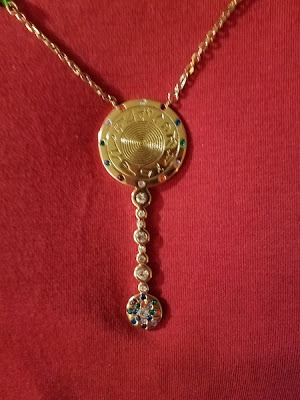
I brought home from China a pendant for Marianne. It was a gift from Jie Zhang, one of my writing students in the Future Affairs Administration writing workshop. That's it up above, in use.
The pendant, as you can see, is a lovely piece of jewelry and Marianne was very happy to receive it. As Jie Zhang explained it to me, the spiral at the center of the piece represents starlight, the symbols around it are the Chinese names for constellations, and the line of stones downward represents the starlight coming down to touch the Earth.
So there's science touching science fiction touching craft. A tight little knot of creativity.
Jie Zhang has a store on Wechat, for those who use that app. Here's (I think) the information for finding it.

And as always . . .
I'm on the road again. This time, I'll be in Iceland -- in part just to gad about, but mostly for Icecon, the national science fiction convention in Reykjavik.
More details as they develop.

Above: As you can see, I've packed everything I need for a tip to the North: a sturdy coat, a sturdy bottle of Scotch, and a sturdy cat.
*

I brought home from China a pendant for Marianne. It was a gift from Jie Zhang, one of my writing students in the Future Affairs Administration writing workshop. That's it up above, in use.
The pendant, as you can see, is a lovely piece of jewelry and Marianne was very happy to receive it. As Jie Zhang explained it to me, the spiral at the center of the piece represents starlight, the symbols around it are the Chinese names for constellations, and the line of stones downward represents the starlight coming down to touch the Earth.
So there's science touching science fiction touching craft. A tight little knot of creativity.
Jie Zhang has a store on Wechat, for those who use that app. Here's (I think) the information for finding it.

And as always . . .
I'm on the road again. This time, I'll be in Iceland -- in part just to gad about, but mostly for Icecon, the national science fiction convention in Reykjavik.
More details as they develop.

Above: As you can see, I've packed everything I need for a tip to the North: a sturdy coat, a sturdy bottle of Scotch, and a sturdy cat.
*
Published on September 28, 2018 07:04
September 21, 2018
Beijing At Night
.

What a wonderful experience Beijing must be to an architect! The city is filled with strange and wonderful buildings. A skyscraper is going about its business when suddenly the windows ripple in strange patterns. Fifteen-story hotels have traditional green-tile roofs. Occasionally, as above, the city even looks like yesterday's science fiction.
What you're looking at is the plaza with reflecting pool in the center of a cluster of buildings, one of which houses the Future Affairs Administration, a publishing house that began, if I recall correctly, as a science fiction fan group. Today, it has some thirty employees and publishes both on the Web and in good old-fashioned books. And it's still growing!
Last week, I ate a fabulous meal in a restaurant on the plaza and then went to a bookstore event on the same plaza. What a rich world this is, and what a remarkable place is Beijing!
Oh, and that yellow thing to the right of center, above? It's a viewing room, where people can enjoy watching the future taking place.
There's another photo of it, from a different angle, below.

*

What a wonderful experience Beijing must be to an architect! The city is filled with strange and wonderful buildings. A skyscraper is going about its business when suddenly the windows ripple in strange patterns. Fifteen-story hotels have traditional green-tile roofs. Occasionally, as above, the city even looks like yesterday's science fiction.
What you're looking at is the plaza with reflecting pool in the center of a cluster of buildings, one of which houses the Future Affairs Administration, a publishing house that began, if I recall correctly, as a science fiction fan group. Today, it has some thirty employees and publishes both on the Web and in good old-fashioned books. And it's still growing!
Last week, I ate a fabulous meal in a restaurant on the plaza and then went to a bookstore event on the same plaza. What a rich world this is, and what a remarkable place is Beijing!
Oh, and that yellow thing to the right of center, above? It's a viewing room, where people can enjoy watching the future taking place.
There's another photo of it, from a different angle, below.

*
Published on September 21, 2018 07:47
September 13, 2018
Oddly Misguided and Possibly Not Even Art
.There's a game I like to play on Facebook every now and again that I call
Art or N'art?
I have a fondness for challenging contemporary art and so when I'm visiting an institutional repository of such work, I'll take a photograph of something that might be art -- or, then again, might simply be a pile of crumbling bricks or some construction debris waiting to be hauled away. Then I'll challenge my friends: Is it art? Or n'art?
The answer, much like the Scarlet Pimpernel can be damned elusive.
Today I took a jaunt to 798 Art Zone, an old industrial neighborhood of Beijing that has been taken over by art centers and galleries and a swarm of parasitic cafes and shops. It was quite wonderful and I hope to return someday and spend a lot more time there. The Ullens Center for Contemporary Art had a major retrospective on Xu Bing, an artist I had never even heard of and now one of my favorites. I may write something about him here, if I can find the time.
I also went to see Muse , which is either a gallery or a show at the 798 Building. And here I find myself punked by my own petard. Art or N'art? Postmodern irony or misguided spectacle? I honestly dunno.
The exhibition consists of a series of room in which famous works by several great painters are projected on the walls... and partially animated.
Renoir's dancers slowly incline their heads toward and away from each other, seemingly caught in a nightmare from which they cannot awaken. All move heavily, sluggishly, as if trying (and failing) to escape the embrace of paint. L uncheon of the Boating Party rocks from side to side, people shifting in relation to each other, as if it were set not on a restaurant balcony but on a boat on a heavy sea. Watching it, I felt seasick.
Van Gogh's people, by contrast, only have to contend with the moving rays of a killer sun.
Gustav Klimt's The Kiss , blown up to fill a wall, suffers from daggers and confetti of light that flow down the image, giving it a kind of Hallmark romanticism, while little colored florettes dance about on the floor, doing their damnedest to distract the viewer from the original image.
A cat wanders through several of Matisse's jostling the bric-a-brac and complaining plaintively. As well it might.
Finally, a room titled Henry's Scissors strives to provide Matisse's cut-outs with a playfulness they already had. Bird-shapes flap, fronds sway, and snippets of blue assemble themselves into women.
Each room is accompanied by its own relentlessly chipper music.
So... Art or N'art? It certainly has the nervy chutzpah of much postmodern art. But if I had to guess (I wouldn't bet money), I'd go with N'art. I think it's a misguided attempt to "bring the classics to life," to make them accessible by turning them into spectacle.
But I could be wrong. Over at Grounds for Sculpture in New Jersey, there's a life-sized Seward Johnson sculpture of Luncheon of the Boating Party which is well on its way to the the thing I saw today.
Which is to say, I'm baffled. Maybe somebody reading this knows for sure? If so... you tell me.
*
The answer, much like the Scarlet Pimpernel can be damned elusive.
Today I took a jaunt to 798 Art Zone, an old industrial neighborhood of Beijing that has been taken over by art centers and galleries and a swarm of parasitic cafes and shops. It was quite wonderful and I hope to return someday and spend a lot more time there. The Ullens Center for Contemporary Art had a major retrospective on Xu Bing, an artist I had never even heard of and now one of my favorites. I may write something about him here, if I can find the time.
I also went to see Muse , which is either a gallery or a show at the 798 Building. And here I find myself punked by my own petard. Art or N'art? Postmodern irony or misguided spectacle? I honestly dunno.
The exhibition consists of a series of room in which famous works by several great painters are projected on the walls... and partially animated.
Renoir's dancers slowly incline their heads toward and away from each other, seemingly caught in a nightmare from which they cannot awaken. All move heavily, sluggishly, as if trying (and failing) to escape the embrace of paint. L uncheon of the Boating Party rocks from side to side, people shifting in relation to each other, as if it were set not on a restaurant balcony but on a boat on a heavy sea. Watching it, I felt seasick.
Van Gogh's people, by contrast, only have to contend with the moving rays of a killer sun.
Gustav Klimt's The Kiss , blown up to fill a wall, suffers from daggers and confetti of light that flow down the image, giving it a kind of Hallmark romanticism, while little colored florettes dance about on the floor, doing their damnedest to distract the viewer from the original image.
A cat wanders through several of Matisse's jostling the bric-a-brac and complaining plaintively. As well it might.
Finally, a room titled Henry's Scissors strives to provide Matisse's cut-outs with a playfulness they already had. Bird-shapes flap, fronds sway, and snippets of blue assemble themselves into women.
Each room is accompanied by its own relentlessly chipper music.
So... Art or N'art? It certainly has the nervy chutzpah of much postmodern art. But if I had to guess (I wouldn't bet money), I'd go with N'art. I think it's a misguided attempt to "bring the classics to life," to make them accessible by turning them into spectacle.
But I could be wrong. Over at Grounds for Sculpture in New Jersey, there's a life-sized Seward Johnson sculpture of Luncheon of the Boating Party which is well on its way to the the thing I saw today.
Which is to say, I'm baffled. Maybe somebody reading this knows for sure? If so... you tell me.
*
Published on September 13, 2018 07:36
September 9, 2018
Why Did the American Cross the Road?
. Much is said about Chinese drivers. But they are models of decorum and circumspection compared to Chinese pedestrians who stroll into the traffic and across the road as if there were not cars coming from both directions and bicycles and electric scooters from all four. Following one's progress is like watching a single fish make its way from one end of an aquarium to the other. How, you wonder, is it possible they don't bump into one another?
Those riding electric scooters, meanwhile, seem to consider themselves honorary pedestrians. While some, women mostly, wait patiently at red lights, others zip on through, confident that such petty inconveniences do not apply to them. They also reserve the right to make right turns on red, left turns on red, and in fact pretty much any motion that occurs to them at the moment. In terms of behavior, bicyclists can be considered to be the scooters' farm team. Nobody takes them very seriously.
The only people who ever seem upset at any of this are those driving automobiles. A car toots impatiently at the old woman six inches from its bumper, who plods unhurriedly onward, never once looking its way.
And as you can tell...
The hostel cafe (the "Twoo Cuup") being closed this morning, I went across the street in search of breakfast. Every smallest thing is an adventure when you're in a foreign land.
*
Those riding electric scooters, meanwhile, seem to consider themselves honorary pedestrians. While some, women mostly, wait patiently at red lights, others zip on through, confident that such petty inconveniences do not apply to them. They also reserve the right to make right turns on red, left turns on red, and in fact pretty much any motion that occurs to them at the moment. In terms of behavior, bicyclists can be considered to be the scooters' farm team. Nobody takes them very seriously.
The only people who ever seem upset at any of this are those driving automobiles. A car toots impatiently at the old woman six inches from its bumper, who plods unhurriedly onward, never once looking its way.
And as you can tell...
The hostel cafe (the "Twoo Cuup") being closed this morning, I went across the street in search of breakfast. Every smallest thing is an adventure when you're in a foreign land.
*
Published on September 09, 2018 19:47
September 8, 2018
Teaching in Beijing
.

Greetings from Beijing! I'm here to teach two sessions of a writers camp for the Future Affairs Administration. The first class was held yesterday and it seems to have gone well.
But let's step back a bit. Years ago, when he was trying to convince me to teach at Clarion West, the late and sorely missed Lucius Shepard said, "You gotta do it, Michael. It'll make you feel like Mr. Chips."
Now, anyone who knew Lucius -- a genuine wild man, if ever there was one -- will have to pause here to try to reconcile the image of him as Mr. Chips with the existence of a universe that makes any kind of sense at all. But when I finally did teach, I discovered what he meant. It's extremely satisfying to be of some use to new writers. They're all potential and good intentions. They deserve all the help one can give.
So it was here, yesterday. Vera Sun, who runs the program for the FAA and affiliated publishing house Guokr, told me that several of the students were published already, one of them with something like eight stories. All were serious, ambitious, intelligent, willing to work hard... everything you want from a new writer. I was greatly impressed by them. Vera also me that their emphasis is on big new ideas. Another thing I am very much in favor of.
Consequently, I'm looking forward to reading their stories. A decade ago, this would have seemed unlikely. But currently there's a lot of corporate sponsorship for SF in China -- a forward-looking literature for a forward-looking nation, you can imagine the discussions in the boardrooms. Part of this sponsorship takes the happy form of underwriting translations of selected works into English. So it's possible to get an idea of the shape of what's currently happening here, even if you can't read Chinese.
(Neil Clarke has been publishing translated Chinese SF stories in Clarkesworld every month. If you're curious, you should go check them out. Along with the rest of his excellent magazine.)
This is, as I've said before, a very exciting time for science fiction in China. They're building something new and, I hope, splendid. I'll have more to say on this matter in the future, I'm sure.
And, yes, teaching here did make me feel like Mr. Chip. Just don't tell anyone I admitted that.
Above: Yes, the Great Wall is outside Beijing and no, I'm not likely to visit it on this trip. But I've been there. One visit is all you really need. It stays in your heart.
*

Greetings from Beijing! I'm here to teach two sessions of a writers camp for the Future Affairs Administration. The first class was held yesterday and it seems to have gone well.
But let's step back a bit. Years ago, when he was trying to convince me to teach at Clarion West, the late and sorely missed Lucius Shepard said, "You gotta do it, Michael. It'll make you feel like Mr. Chips."
Now, anyone who knew Lucius -- a genuine wild man, if ever there was one -- will have to pause here to try to reconcile the image of him as Mr. Chips with the existence of a universe that makes any kind of sense at all. But when I finally did teach, I discovered what he meant. It's extremely satisfying to be of some use to new writers. They're all potential and good intentions. They deserve all the help one can give.
So it was here, yesterday. Vera Sun, who runs the program for the FAA and affiliated publishing house Guokr, told me that several of the students were published already, one of them with something like eight stories. All were serious, ambitious, intelligent, willing to work hard... everything you want from a new writer. I was greatly impressed by them. Vera also me that their emphasis is on big new ideas. Another thing I am very much in favor of.
Consequently, I'm looking forward to reading their stories. A decade ago, this would have seemed unlikely. But currently there's a lot of corporate sponsorship for SF in China -- a forward-looking literature for a forward-looking nation, you can imagine the discussions in the boardrooms. Part of this sponsorship takes the happy form of underwriting translations of selected works into English. So it's possible to get an idea of the shape of what's currently happening here, even if you can't read Chinese.
(Neil Clarke has been publishing translated Chinese SF stories in Clarkesworld every month. If you're curious, you should go check them out. Along with the rest of his excellent magazine.)
This is, as I've said before, a very exciting time for science fiction in China. They're building something new and, I hope, splendid. I'll have more to say on this matter in the future, I'm sure.
And, yes, teaching here did make me feel like Mr. Chip. Just don't tell anyone I admitted that.
Above: Yes, the Great Wall is outside Beijing and no, I'm not likely to visit it on this trip. But I've been there. One visit is all you really need. It stays in your heart.
*
Published on September 08, 2018 18:56
August 17, 2018
Good Fun at the KGB
.
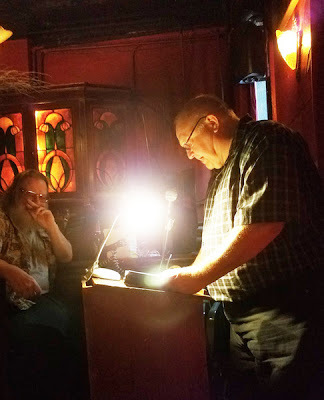
It was a grand night Wednesday at the KGB Bar science fiction reading series. The chief draw was Jeffrey Ford, who read two excerpts from his new novel, Ahab's Return: or, The Last Voyage to great acclaim. The premise -- that Captain Ahab survived the wreck of the Pequod and is now searching for his lost wife and child in New York City -- is exactly the kind of thing I never read. But, having heard Jeff read from it, I've resolved to buy the book in hardcover.
This is, incidentally, another good reason to attend readings. Aside from the fun of it, I mean. Learning about books you didn't know you wanted.
That's Jeff up top, reading.
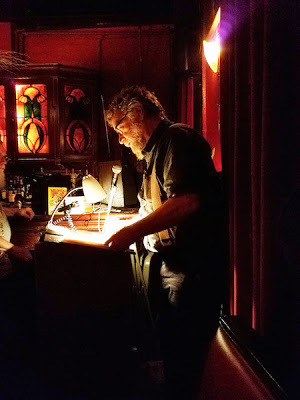
And this next picture (photo credit: Marianne Porter) is of me. I also read two pieces. The first was "Ghost Ships," a short story that is radically different from anything I've written before. It got a very good reception, which I don't mind admitting was heartening.
I also read a slightly-condensed version of the ending of "T he City of Men," the novella that Gardner Dozois and I were working on when he died. This is a sequel or continuation of "The City of God," published in 1995 in Omni Online and subsequently reprinted in Asimov's Science Fiction. The first novella was extremely dark and so, too, is the second -- until you come to the ending, which is unabashedly happy. Gardner had talked about that ending for decades and he almost got to write it. But at least it got written in the end, even if not by him. Making the novella a fitting memorial to the man.
Then, because Gardner had always admired Robert Silverberg's innovation when John Brunner died, I asked if the crowd could honor Gardner with, not a moment of silence but a moment of applause.
The crowd did so. The applause seemed to go on forever. It's possible it's still going on now, even as you read these words.

Oh, and I should probably mention that the crowds that the KGB readings draw are made up of the cream of the New York science fiction scene: writers, editors, SF professionals and the like. All by themselves, they're reason enough for NYC residents who love science fiction to show up.
Up above: My rather blurry photo of the rather fine writer Richard Bowes, drinking a glass of uisce solais.
*

It was a grand night Wednesday at the KGB Bar science fiction reading series. The chief draw was Jeffrey Ford, who read two excerpts from his new novel, Ahab's Return: or, The Last Voyage to great acclaim. The premise -- that Captain Ahab survived the wreck of the Pequod and is now searching for his lost wife and child in New York City -- is exactly the kind of thing I never read. But, having heard Jeff read from it, I've resolved to buy the book in hardcover.
This is, incidentally, another good reason to attend readings. Aside from the fun of it, I mean. Learning about books you didn't know you wanted.
That's Jeff up top, reading.

And this next picture (photo credit: Marianne Porter) is of me. I also read two pieces. The first was "Ghost Ships," a short story that is radically different from anything I've written before. It got a very good reception, which I don't mind admitting was heartening.
I also read a slightly-condensed version of the ending of "T he City of Men," the novella that Gardner Dozois and I were working on when he died. This is a sequel or continuation of "The City of God," published in 1995 in Omni Online and subsequently reprinted in Asimov's Science Fiction. The first novella was extremely dark and so, too, is the second -- until you come to the ending, which is unabashedly happy. Gardner had talked about that ending for decades and he almost got to write it. But at least it got written in the end, even if not by him. Making the novella a fitting memorial to the man.
Then, because Gardner had always admired Robert Silverberg's innovation when John Brunner died, I asked if the crowd could honor Gardner with, not a moment of silence but a moment of applause.
The crowd did so. The applause seemed to go on forever. It's possible it's still going on now, even as you read these words.

Oh, and I should probably mention that the crowds that the KGB readings draw are made up of the cream of the New York science fiction scene: writers, editors, SF professionals and the like. All by themselves, they're reason enough for NYC residents who love science fiction to show up.
Up above: My rather blurry photo of the rather fine writer Richard Bowes, drinking a glass of uisce solais.
*
Published on August 17, 2018 08:12
August 3, 2018
A Simple Plot Diagram
.

I drew up the above diagram last night as a tool to help me with a story I'm having some difficulty with. There are two main characters, Olav and Nahala, each represented by their middle initials. The main line shows their journey through the story. The small circles are particularly significant events in the story. And the arrows converging on the small circles are characters and forces introduced at that point.
Simple, yes?
So what, you ask, is the point? Well, I've got about 2,500 words written, including the first six pages which are pretty much final draft, and the final three or four paragraphs, also final draft. Plus a batch of stuff that falls somewhere in between. But while I know what must happen in the broadest outline (Olav must agree to work for a wizard, he must fight a dragon, and that fight must have a certain unexpected conclusion), the details of how the story will accomplish these things are not exactly clear. By sketching out what I know, I accomplish two things:
1) I discover aspects of the shape of the story I didn't know. For example, it turns out that the story falls into four distinct sections, which suggests alternating point of view between Olav and Nahala.
2) At the crucial plot points, as I'm tightly focused on them, I make marginal notes: snippets of dialog, observations about character and setting, and the like. These, when I go to write, can be expanded. So if I'm feeling uninspired, I can just go to the notes and start inserting them into the story.
Luckily, this is not a very complicated tale. It might be a short as 5,000 words. It's definitely going to be a short story, rather than a novella or a novelette.
*

I drew up the above diagram last night as a tool to help me with a story I'm having some difficulty with. There are two main characters, Olav and Nahala, each represented by their middle initials. The main line shows their journey through the story. The small circles are particularly significant events in the story. And the arrows converging on the small circles are characters and forces introduced at that point.
Simple, yes?
So what, you ask, is the point? Well, I've got about 2,500 words written, including the first six pages which are pretty much final draft, and the final three or four paragraphs, also final draft. Plus a batch of stuff that falls somewhere in between. But while I know what must happen in the broadest outline (Olav must agree to work for a wizard, he must fight a dragon, and that fight must have a certain unexpected conclusion), the details of how the story will accomplish these things are not exactly clear. By sketching out what I know, I accomplish two things:
1) I discover aspects of the shape of the story I didn't know. For example, it turns out that the story falls into four distinct sections, which suggests alternating point of view between Olav and Nahala.
2) At the crucial plot points, as I'm tightly focused on them, I make marginal notes: snippets of dialog, observations about character and setting, and the like. These, when I go to write, can be expanded. So if I'm feeling uninspired, I can just go to the notes and start inserting them into the story.
Luckily, this is not a very complicated tale. It might be a short as 5,000 words. It's definitely going to be a short story, rather than a novella or a novelette.
*
Published on August 03, 2018 13:13
July 31, 2018
Dream Diary: July 30, 2018
.I dreamed I dropped by Janis Ian's house for an unannounced visit -- which was pretty cheeky of me, considering she lives in a different region of the country from me. We chatted and she mentioned that that evening she was going to be in a music video with Hank Williams, for whom she'd written a song. Then she asked if I'd like to be an extra in the video.
I said yes, while reflecting on the irony that I'd had to beg off a similar invitation to appear in a music video from Neil Gaiman, because it conflicted with my visit to Janis.
(I do apologize for all the name-dropping. But that was the dream I had. The conversation, as I remember it, was a pleasant one.)
And does this mean I'll be posting here regularly again...?
I hope so. Then again, I've been intending to promise to do so for weeks, and things keep coming up. So we'll see. My intentions are good, even if the flesh is weak.
*
I said yes, while reflecting on the irony that I'd had to beg off a similar invitation to appear in a music video from Neil Gaiman, because it conflicted with my visit to Janis.
(I do apologize for all the name-dropping. But that was the dream I had. The conversation, as I remember it, was a pleasant one.)
And does this mean I'll be posting here regularly again...?
I hope so. Then again, I've been intending to promise to do so for weeks, and things keep coming up. So we'll see. My intentions are good, even if the flesh is weak.
*
Published on July 31, 2018 07:18
July 9, 2018
Eight Pictures from the Gardner Dozois Memorial
.

The memorial for Gardner Dozois was held Saturday at the Friends Center in Center City Philadelphia. Well over a hundred people showed up (I doubt anybody counted) to honor and remember a brilliant writer and editor and one of the best and kindest men I've ever known.
I've written many thousands of words of memorials and appreciations over he past month, so today I'll just post a few pictures with minimalist captions.
Above: Gardner's son, Christopher Casper. His words were the wisest and most heartfelt of the day.

Tess Kissinger sharing memories of Gardner.
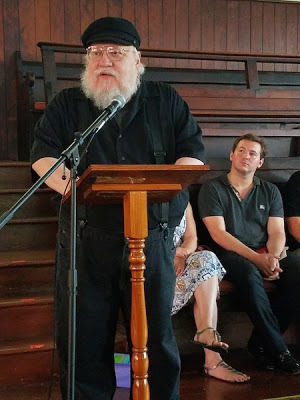
"Look -- manatees!" George R. R. Martin tells a very funny story about the old days.
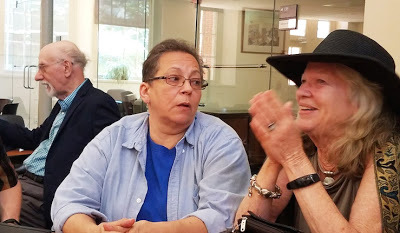
Left to right: Tom Purdom, Barbara Hearn, Margaret King.
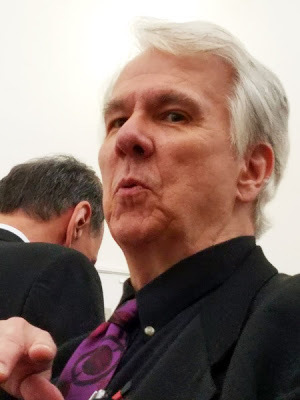
Gregory Frost somehow looking both mischievous and elegant.
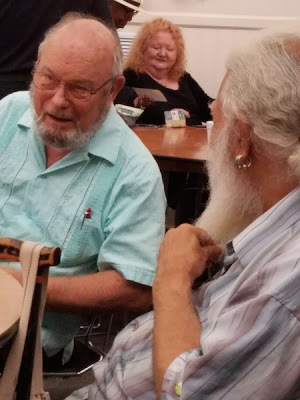
Joe Haldeman sharing a story with Chip Delany. Tess Kissinger is in the background.
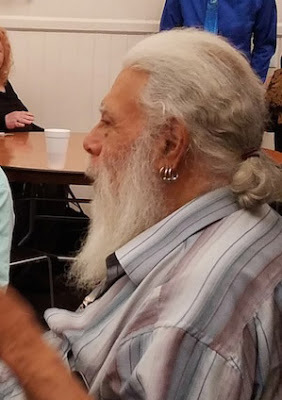
Chip again.
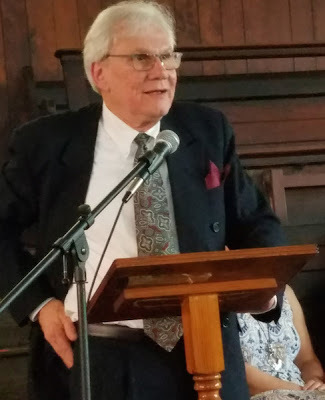
And Jack Dann.
All in all, a very sad event, laced with laughter.
*

The memorial for Gardner Dozois was held Saturday at the Friends Center in Center City Philadelphia. Well over a hundred people showed up (I doubt anybody counted) to honor and remember a brilliant writer and editor and one of the best and kindest men I've ever known.
I've written many thousands of words of memorials and appreciations over he past month, so today I'll just post a few pictures with minimalist captions.
Above: Gardner's son, Christopher Casper. His words were the wisest and most heartfelt of the day.

Tess Kissinger sharing memories of Gardner.

"Look -- manatees!" George R. R. Martin tells a very funny story about the old days.

Left to right: Tom Purdom, Barbara Hearn, Margaret King.

Gregory Frost somehow looking both mischievous and elegant.

Joe Haldeman sharing a story with Chip Delany. Tess Kissinger is in the background.

Chip again.

And Jack Dann.
All in all, a very sad event, laced with laughter.
*
Published on July 09, 2018 15:06
June 22, 2018
Flogging the Time Machine!
.
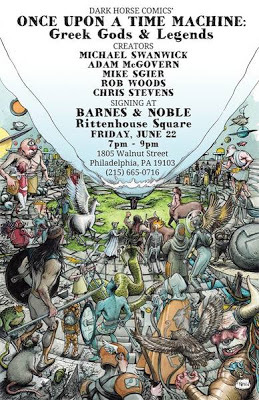
A decent respect for my editors and publishers requires that I mention that I will be making an appearance tonight at 7:00 p.m. at the Rittenhouse Square Barnes & Noble. Along with other comix creators, of course. All in support of the Once Upon a Time Machine: Greek Gods & Legends anthology.
If you're in the area, why not drop by?
And last night in LIttle Narnia . . .
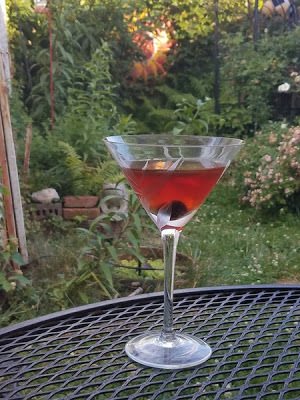
The American Martini Institute is often thought of as being solely about the Martini. It's the name, I suppose. But in fact, that august organization actively researches all manner of cocktails. In fact, the AMI met in solemn convocation last night for a taste-testing of Canadian Club's 100% Rye Whiskey. If one is to appreciate what American rye whiskey was and has become, this is , ironically enough, the place to start.
Why ironically? Because Canadian Rye Whisky and American Rye Whiskey are two different, though related cats -- and not just because the American version has an extra 'e' in its name. American rye, by law, just contain at least 51% rye in its mash, while the Canadian version only has to taste the way Canadians think a proper rye whisky should.
There was a time in the United States when 'whiskey' meant rye whiskey. Remember the Whiskey Rebellion? It was all about the rye. Pennsylvania and Maryland were the primary producers of rye whiskey, leaving bourbon, with its corn mash, for the Southern states -- Kentucky in particular. Allegheny County in Pennsylvania became the center for distilling Monongahela Rye. More on that in a later post.
But a funny thing happened. Rye fell out of flavor. The chief culprit was Prohibition, the mad experiment in social control which sent a generation of Americans to their bathtubs to concoct a witch's brew of alcoholic beverages that no civilized human being should have to imbibe.
During this nightmarish period, the best smuggled alcohol came from Canada -- and Canadians, as a whole, like their whisky smooth. By the time American drinkers emerged from the Age of Savagery, they had no choice but to acknowledge the superior sophistication of our brothers to the north.
Rye whiskey went into eclipse. And what could be bought pretty much uniformly hugged that 51% legal minimum. Even rye drinkers liked the flavor mellowed out with corn and malted barley in the mash.
Old Overholt, one of the most prominent of the Monongahela Ryes, was sold and reformulated. Now it's a high-corn whiskey made the Jim Beam distilleries in Kentucky.
But the winds of fashion are fickle things. Today, rye is back in favor again. Boutique distilleries are popping up everywhere. And Canadian Club, bless 'em, has put out an affordable single-rye whisky.
Now, as to the tasting...
The color is lovely, a rich amber. The nose and flavor both are strongly caramel with strong spice and notes of not English Walnut but, appropriately enough, American Black Walnut. The flavor is emphatic and, it has to be said, to the modern palate might seem just a touch harsh. This is not a sipping whisky. The caramel does tend to dominate.
But the proof of a good rye lies in how well it goes in a Manhattan. So Manhattans were made:
(Marianne spices our cherries in Maraschino liqueur, so as to avoid the horror of candied cherries.)
And the result?
It has to be said, this is a magnificent Manhattan. The rye's flavor is strong and emphatic -- in, I hasten to add, the very best way. The subtleties of the whisky come through. And the vermouth, bitters, and cherry tame the more rambunctious qualities of the naked whisky.
More research will be published here in future postings.
*

A decent respect for my editors and publishers requires that I mention that I will be making an appearance tonight at 7:00 p.m. at the Rittenhouse Square Barnes & Noble. Along with other comix creators, of course. All in support of the Once Upon a Time Machine: Greek Gods & Legends anthology.
If you're in the area, why not drop by?
And last night in LIttle Narnia . . .

The American Martini Institute is often thought of as being solely about the Martini. It's the name, I suppose. But in fact, that august organization actively researches all manner of cocktails. In fact, the AMI met in solemn convocation last night for a taste-testing of Canadian Club's 100% Rye Whiskey. If one is to appreciate what American rye whiskey was and has become, this is , ironically enough, the place to start.
Why ironically? Because Canadian Rye Whisky and American Rye Whiskey are two different, though related cats -- and not just because the American version has an extra 'e' in its name. American rye, by law, just contain at least 51% rye in its mash, while the Canadian version only has to taste the way Canadians think a proper rye whisky should.
There was a time in the United States when 'whiskey' meant rye whiskey. Remember the Whiskey Rebellion? It was all about the rye. Pennsylvania and Maryland were the primary producers of rye whiskey, leaving bourbon, with its corn mash, for the Southern states -- Kentucky in particular. Allegheny County in Pennsylvania became the center for distilling Monongahela Rye. More on that in a later post.
But a funny thing happened. Rye fell out of flavor. The chief culprit was Prohibition, the mad experiment in social control which sent a generation of Americans to their bathtubs to concoct a witch's brew of alcoholic beverages that no civilized human being should have to imbibe.
During this nightmarish period, the best smuggled alcohol came from Canada -- and Canadians, as a whole, like their whisky smooth. By the time American drinkers emerged from the Age of Savagery, they had no choice but to acknowledge the superior sophistication of our brothers to the north.
Rye whiskey went into eclipse. And what could be bought pretty much uniformly hugged that 51% legal minimum. Even rye drinkers liked the flavor mellowed out with corn and malted barley in the mash.
Old Overholt, one of the most prominent of the Monongahela Ryes, was sold and reformulated. Now it's a high-corn whiskey made the Jim Beam distilleries in Kentucky.
But the winds of fashion are fickle things. Today, rye is back in favor again. Boutique distilleries are popping up everywhere. And Canadian Club, bless 'em, has put out an affordable single-rye whisky.
Now, as to the tasting...
The color is lovely, a rich amber. The nose and flavor both are strongly caramel with strong spice and notes of not English Walnut but, appropriately enough, American Black Walnut. The flavor is emphatic and, it has to be said, to the modern palate might seem just a touch harsh. This is not a sipping whisky. The caramel does tend to dominate.
But the proof of a good rye lies in how well it goes in a Manhattan. So Manhattans were made:
Manhattan
3 parts rye
1 part sweet vermouth
2 dashes cherry bitters
shake over ice
serve in a cocktail glass with spiced cherries
(Marianne spices our cherries in Maraschino liqueur, so as to avoid the horror of candied cherries.)
And the result?
It has to be said, this is a magnificent Manhattan. The rye's flavor is strong and emphatic -- in, I hasten to add, the very best way. The subtleties of the whisky come through. And the vermouth, bitters, and cherry tame the more rambunctious qualities of the naked whisky.
More research will be published here in future postings.
*
Published on June 22, 2018 08:14
Michael Swanwick's Blog
- Michael Swanwick's profile
- 546 followers
Michael Swanwick isn't a Goodreads Author
(yet),
but they
do have a blog,
so here are some recent posts imported from
their feed.



